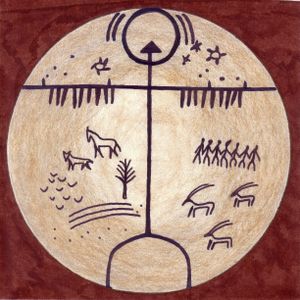What is a shaman?
The word was
borrowed by anthropologists from the Tungus Siberian people. Correctly
pronounced, the long As (“ah”) are given equal weight (“shah-mahn”); the magic
of the word is in its resonance. The word came into widespread use after the
publication of Mircea Eliade’s classic work Shamanism,
An Archaic Technique of Ecstasy. In Eliade’s depiction, the shaman is a
spiritual practitioner who has mastered the art of journeying beyond the body
to communicate with the spirits, to guide souls of both the living and the
departed, and to bring through healing.
n Central Asia, the shaman’s primary tool for journeying is
the single-headed frame drum, the type we use in Active Dreaming circles. There
is a Buriat story about how the shaman’s drum came to be this way. Long ago,
Death complained to the High God that a powerful shaman was disturbing the
balance of things. This shaman was so successful at bringing the souls of the dying
back into the body that Death was being cheated of his share. The High God
reached down from the heavens, plucked the vital soul of a perfectly healthy
man out of his body, confined it inside a bottle and sat on his high throne,
waiting to see what the shaman would do.
Approached by the family of the unfortunate man who now lay lifeless, the shaman mounted his
drum – which he called his “horse” – and rode it through the Lower World and the
Middle World, looking for the missing soul. To fulfill his quest, he had to journey higher
than he had ever gone before, into the Upper World, until at last he saw the
High God on his high throne holding the soul in the bottle. Even the boldest of
shamans might have given up at this point. But this shaman refused to abandon
his mission. He shapeshifted into a wasp and stung the High God on the
forehead. Shocked and in pain, the High God relaxed his grip on the bottle. The
shaman grabbed the captive soul and began to gallop back towards his village
with it. The High God, in fury, hurled a lightning bolt after him. It split the
shaman’s drum – hitherto double-headed – in two, giving us the classic form of
the drum as we know it today.
From this wild,
archaic story, several vital aspects of the shaman’s practice emerge. The
shaman works with souls. The shaman has the ability to travel at will through a
three-tiered universe – Lower World, Middle World, Upper World – that opens
into a multidimensional cosmos. The shaman has developed the art of
shapeshifting. The shaman is on intimate terms with death. The shaman is
willing to test the limits of the possible. The shaman serves the community.
Cross-culturally,
we find that these statements hold true of authentic shamans in many different
societies. “The only thing of importance in a man is the soul,” an Inuit
shaman, or angakok, told the explorer
Knud Rasmussen. Ancient Taoists in China described the heart of their
shamanic practice as “the art of ascending to heaven in full daylight”, and
sought to master the techniques of “crane-riding” – traveling to the skies on
the wings of the crane, or the wild duck, or the dragon, or the flying tiger.
When asked how he heals, an Aboriginal spirit man told Jungian analyst Robert
Bosnak, “I become an eagle.” Everywhere, as Holger Kalweit observes in Dreamtime and Inner Space, the shaman
walks close to death. He knows the roads of the afterlife because he has
traveled them personally; “he actually dies and is actually reborn.”
In indigenous
cultures, shamans may be born into a lineage and may undergo ritual training,
ordeal and initiation. But the shaman’s calling is typically announced through
a highly individual crisis. This may involve a serious illness or a near-death experience.
Most frequently, the shaman’s calling is announced in dreams and visions. Among
the Anishnabe or Ojibwa, the revelation of a shaman’s calling – or whatever form our soul’s
purpose may take – is frequently the gift of a dream guide, or pawauganuk.
Shamans are not
only called by dreams; dreaming is at the core of their practice. An Amazonian
people, the Kagwahiv, say that “everyone who dreams is a little bit shaman.”
Indeed, the most common name for the shaman in the Western Hemisphere means simply, “one who dreams”. In
Mohawk, the word is atetshents (masculine
form: ratetshents), pronounced
“adze-edze-ots”. It means “dreamer” in the sense of one who dreams strong, one
who dreams true, one who can travel in dreaming and heal others inside the dreamspace. It also means “doctor” and “healer”.
There we have the ancient understanding that to be a shaman, or doctor, or healer, you
must be at home in the dreamworlds.
When I found
myself, in dreams, inside the world of ancient Iroquoian shamans and healers, an Onondaga elder told me, “You made some visits
and you received some visitations.” That is the basic shamanic understanding of
what goes on in interesting dreams – we travel somewhere, or receive a visit.


